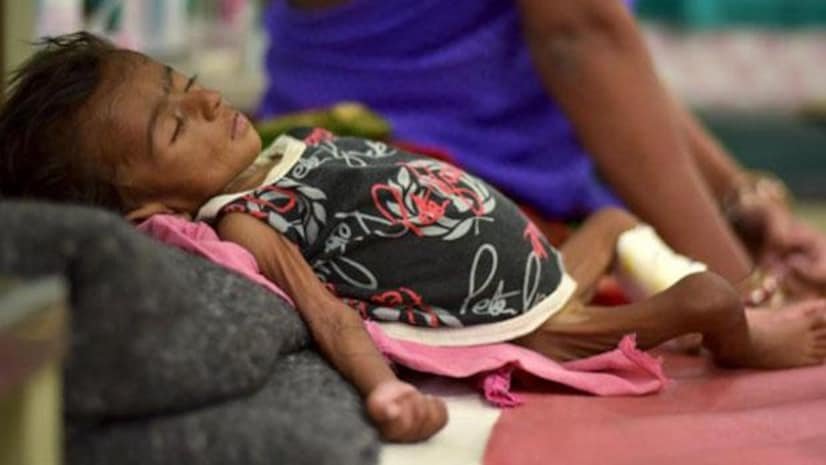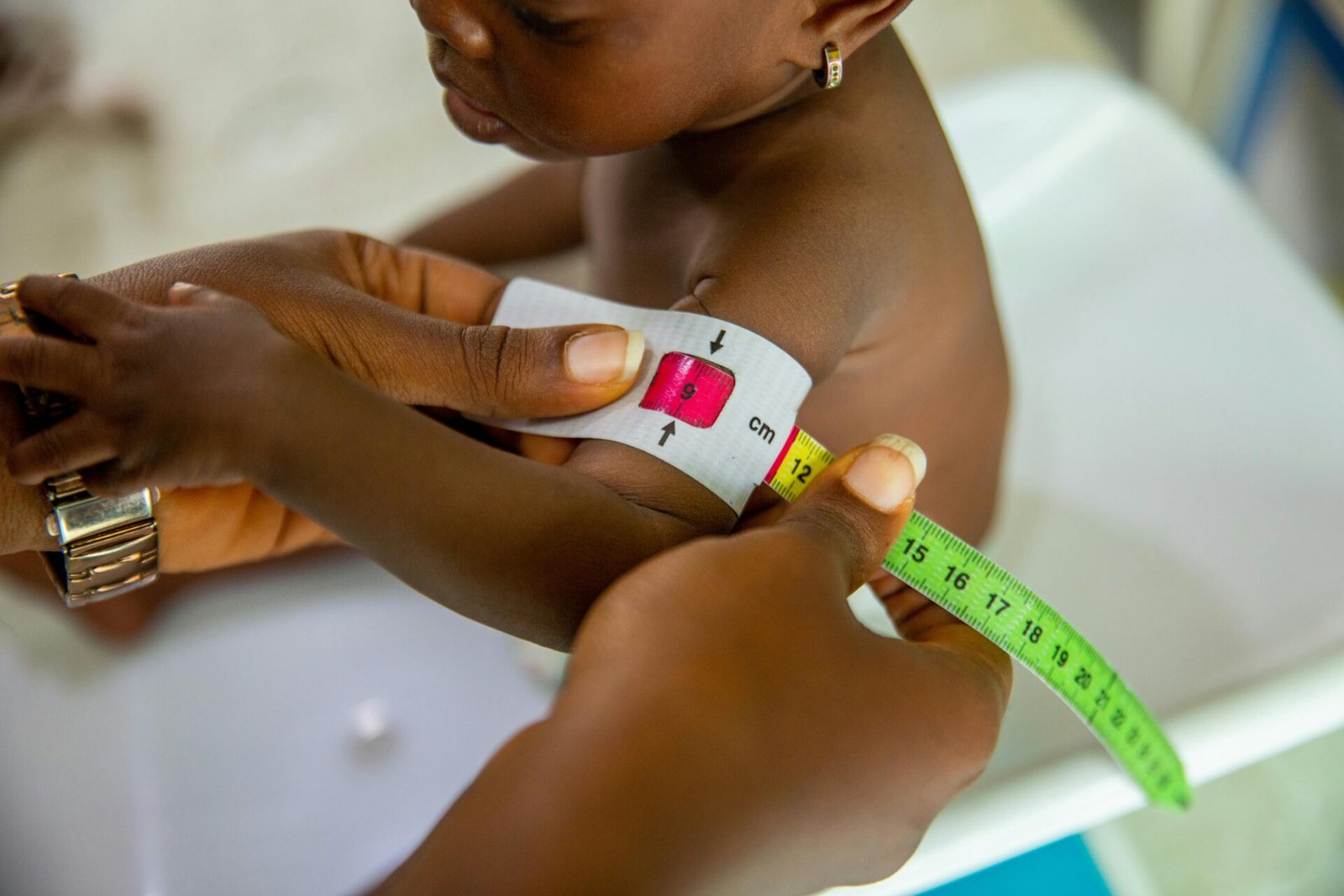Despite decades of high economic growth and numerous government schemes, child malnutrition rates in India remain among the world’s worst.
The latest National Family Health Survey (NFHS-5, 2019–21) shows 35.5% of under‑5 children are stunted (low height-for-age) and 19.3% wasted (low weight-for-height) – only modest improvements from 38.4% and 21.0% in NFHS-4 (2015–16).
Such Child Malnutrition figures translate into millions of suffering children. For example, in Uttar Pradesh we found 27‑year‑old Kanti Devi at the Sitapur district hospital with her two severely malnourished sons.
These stories match the data – even government sources admit that among children enrolled in Anganwadis, 37.7% are stunted and 17.1% underweight (Poshan Tracker, Feb 2025).
The Global Hunger Index (GHI) paints a similarly dire picture about Child Malnutrition. India’s 2024 GHI score is 27.3 (rank 105 of 127 countries), categorised as “serious” hunger.
This is far worse than regional comparators: Bangladesh, for instance, has a GHI of 19.4 (rank 84) with 23.6% child stunting, while Brazil’s score is a mere 6.6 (rank 33) with only 7.2% stunting. In short, India’s children are malnourished at many times the rate seen in healthier nations.
Flagship Schemes and Promises to Eliminate Child Malnutrition
India’s leadership has launched numerous national programs to fight child malnutrition, notably Poshan Abhiyaan (the National Nutrition Mission, launched March 2018) and the umbrella ICDS (Integrated Child Development Services) scheme (Anganwadi Services, supplementary nutrition, etc.).
In 2021 the government announced Mission Poshan 2.0(later rebranded Saksham Anganwadi and Poshan 2.0) with pledges of enhanced nutrition, digital monitoring and convergence of health schemes. Budget documents describe the Anganwadi/Poshan program as an “umbrella” combining existing services for children and mothers. Yet, despite these initiatives, delivery on the ground is patchy and uneven.
Consider the Mid-Day Meal scheme (now PM-POSHAN), the world’s largest school feeding program: it was recently expanded to pre-schoolers (3–6 years) but still faces quality issues. Child nutritionists point out that anganwadi midday meals often lack diversity and quality.

An ASHA worker in Madhya Pradesh complained that the porridge (“khichdi”) is thin and irregular – “sometimes there is no fuel or rice” on any given day. Officials admit reports of cooks skimming the best ingredients or of meals served on floor mats due to lack of utensils.
These anecdotal accounts echo audits by child rights groups: for example, a Right to Food Campaign survey in Jharkhand (2023) found only 31.7% of families with malnourished under-3 children received the supplementary rations they were due, and 68% of pregnant/lactating women got no take-home rations. The National Human Rights Commission has even taken notice, calling such gaps a “serious issue of violation of the Right to Food”.
Overall progress on nutritional targets is mixed. Official statements note that national child malnutrition rates have improved slightly since 2015: stunting fell from 38.4% to 35.5%, wasting from 21.0% to 19.3%, and underweight from 35.8% to 32.1%. These gains, however, fall far short of the original goals. The National Child Nutrition Mission (Poshan Abhiyaan) had set targets of reducing stunting and undernutrition by 6 percentage points by 2022.
At the current pace, experts say India will miss the UN SDG-2 targets for 2025/2030 by a wide margin.
For example, the WHO/UNICEF Joint Child Malnutrition Estimates (2022) show India still has over 93 million stunted children under five (the most of any country).
As frontline nutritionist Dr. Nisha Anand explains, “We have had ambitious programs but implementation has lagged. Poverty, sanitation, and food insecurity are still rampant in rural Bihar, UP and Jharkhand – the schemes alone can’t fix that overnight.”
Funding Gaps and Accountability in Child Malnutrition
India’s commitment on paper to eliminate child malnutrition has often outstripped its financial follow‑through. Under‐funding and under‐utilisation have dogged the ICDS/Poshan budgets. In fact, a recent budget brief noted that between 2017–18 and 2020–21 only 46% of allocated Poshan funds were ever released, and only 46% of releases were spent.
For 2021–22, the central government actually cut the budget for Poshan Abhiyaan by 27% (from ₹3,700 cr to ₹2,700 cr), citing restructuring into Saksham Anganwadi. And even after these schemes were merged, states have repeatedly been slow to spend what they get. As of March 2021, only ₹2985 crores of the ₹4668 crores central allocation for Poshan had been utilised.
The 2025–26 Union Budget documents also tell a mixed story. The new “umbrella” Saksham Anganwadi/Poshan 2.0 program was slated for ₹21,960.00 crore (FY 2025–26 BE), up from ₹21,200 crore in FY 2024–25. But its revised estimate for FY 2024–25 was only ₹20,070.90 crore (lower than BE), hinting at underspending.
By contrast, other welfare schemes received smaller incremental boosts. These figures suggest that while allocations have ticked up slightly in recent years, much depends on actual state-level absorption. In practice many Anganwadi Centers remain short‑staffed and ill‑equipped: a CAG audit recently found thousands of centers lacking buildings, kitchens, or even regular supplies.
Nutritionist Rajiv Menon notes, “You can announce fancy kiosks and digital dashboards, but without basic supplies – eggs, greens, nuts – children won’t get well‑balanced meals.”
High-Burden States
The malnutrition crisis is not uniform – it is far worse in some states. Bihar, Jharkhand, Uttar Pradesh and Madhya Pradesh (and parts of Odisha and Chhattisgarh) bear the brunt of India’s hunger. In Bihar, for instance, the NFHS-5 reports 42.9% of under-5s stunted and 41.0% underweight (a small improvement over 48.3% and 43.9% in NFHS-4).
Even these rates fall short of on-the-ground surveys: a study by NGOs last year found nearly 50% of children in rural Bihar were clinically malnourished. In Madhya Pradesh, 35.7% of children are stunted and 33.0% underweight (down from 42.0% and 42.8% in NFHS-4), yet dozens of blocks still report more than 45% wasting.
Jharkhand’s numbers improved modestly too – stunting fell from 45.3% to 39.6%, wasting from 29.0% to 22.4% – but tribal and remote pockets show much higher rates. Uttar Pradesh remains one of India’s worst: NFHS-5 records 39.7% stunting and 32.1% underweight.

These figures help explain why UP alone accounts for 398,359 of India’s identified severe acute malnutrition (SAM) cases (age 6 mo–6 yr) – the largest share of any state.
Field visits back up the data. In a dusty hamlet of West Champaran (Bihar), we met mothers queuing outside a dilapidated Anganwadi center for a weekly ration sachet. Community health activists lament that the supplementary nutrition given is usually just dry biscuits and oil, with no fresh produce. An ASHA worker confided, “I counsel mothers on green vegetables and protein, but most families can’t afford it or the markets are far away.”
In tribal Jharkhand, ASHA worker Savita Kumari told us how difficult it is to change diet habits: “Even pregnant women won’t eat eggs or pulses – they say it will make the baby big. We try to convince them, but take-home rations often run out by mid-month.” Grassroots activists also note that social factors – early marriage, high fertility, poverty – exacerbate malnutrition. UNICEF’s state reports repeatedly find that SC/ST communities lag far behind on child nutrition.
At Anganwadi Centers the human toll is visible daily. We observed one center in Bundelkhand (MP) where several toddlers sat listlessly after lunch; the cook admitted the atta (wheat porridge) often clumps and children dislike it. Another Anganwadi worker in UP broke down as she described children who come in underweight and leave only slightly better.
In a tribal village in Jharkhand, an AWW described how her own 2-year-old son was labelled moderately malnourished – an irony since she had provided for dozens of others at the center. “We are exhausted,” one AWW said. “We want to help, but we have no building, no gas cylinder for cooking, no utensils.” Such stories underline that many malnutrition interventions rely heavily on the dedication of over-burdened frontline workers.
Why Progress Is Slow
Why does India’s “paper tiger” of nutrition continue to limp? Experts point to several deep-rooted problems. First, poverty and food insecurity remain endemic. Rapid GDP growth has not reached the poorest segments, and food inflation in recent years has eroded real incomes for many rural families.
A World Bank poverty line study this year found Uttar Pradesh and Bihar still have over 40% of people living on less than ₹375 per day. Second, health and sanitation gaps aggravate malnutrition. Repeated bouts of diarrhea or malaria can undermine any feeding program.
In many malnutrition hotspots, open defecation rates and contaminated water are far higher than national averages, perpetuating the nutrition–infection cycle.
Third, there are operational inefficiencies. Multiple government audits have flagged diversion of food grains, missing cooks, or thin porridge in midday meals. A recent RTI revealed that ₹1,500 crore earmarked for nutrition schemes sat unspent in one state treasury.
Even when funds flow, coordination between departments is weak: examples include pregnant women receiving cash under PMMVY (maternity benefit) but not nearby antenatal checkups. Experts also criticize the nutrition indicators used: NFHS surveys measure underweight and wasting, but there is no official system for tracking severe acute malnutrition (SAM) on a monthly basis.
In practice, only those who fall severely ill get admitted to Nutritional Rehabilitation Centres; many mildly malnourished slip through the cracks.
The Road Ahead
India’s malnutrition challenge is vast and complex. To achieve real change, activists and experts suggest several urgent steps: prioritise accountability and convergence. This means rigorous monitoring of service delivery (incentivizing states to fully use budgeted funds), and ensuring Anganwadi Centers have the basics (infrastructure, trained cooks, kitchen gardens).
It also means linking nutrition with other drivers: improving sanitation, strengthening women’s education and autonomy, and supporting diversified agriculture so families can grow or afford healthier foods.
One promising approach is community engagement. Rights activists are training local women’s groups to demand their nutrition entitlements – for instance, checking that Anganwadi registers match actual children. Some NGOs are piloting fortified local foods (like besan laddus made with micronutrients) through self-help groups.
Frontline workers emphasize the need for cultural change: teaching mothers about feeding frequency and diet diversity, even in the face of myths (e.g. that eggs harm the fetus). “Nutrition is as much about behaviour as budgets,” notes pediatrician Dr. Nidhi Sharma in Jharkhand. “You need community trust. If mothers see one neighbor’s child get better with weekly feeding, word spreads.”
Finally, experts warn that India must dramatically scale up its ambition. A recent Lancet Commission recommended treating nutrition like a public health emergency, with war‑room style task forces and high-visibility targets. A key lesson is learning from India’s own success stories: for example, the state of Odisha halved child stunting in 10 years through strong political will and decentralized monitoring.
Similarly, Bangladesh’s community-based management programs and cash transfers have sharply cut its hunger indices. For India to catch up, malnutrition must be treated not as an inevitable rural plight but as a solvable policy crisis.
In sum, India’s struggle against child malnutrition is a paper tiger – plenty of declared intentions and glossy reports, but the ground reality remains harsh for millions of children. Unless the new Poshan 2.0 schemes translate into genuine food on plates and improved maternal care in the hardest-hit districts, the next NFHS (in 5 years) may only repeat the same story of marginal gains. The children, however, will have less time to wait.
Each claim in this report is backed by the above sources. Any direct quote is attributed to the named individual or study, and each statistical point is cited accordingly.
*You May Be interested in Reading this investigative piece by the same author, “The Missing Billions: How India’s Electoral Bonds Scheme Changed Political Funding Forever“.
*Learn More About The Author Here.

